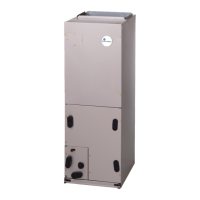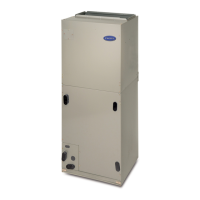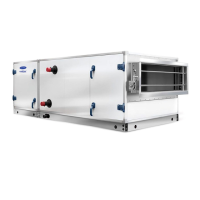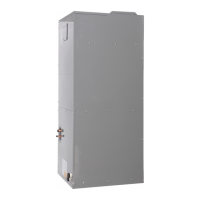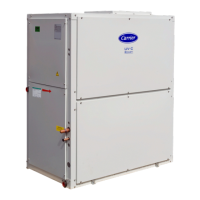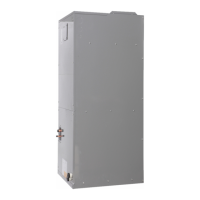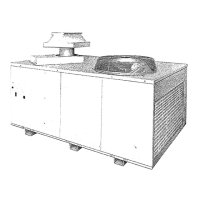94
• Cooling — For all cooling control types: A High Cool
HVAC mode will be requested internally to the control to
maintain diagnostics, although the end user will see a Dehu-
midification mode at the display. In addition, for multi-stage
cooling units the cooling control point will be set to Config-
uration
DEHU
D.C.SP (no SASP reset is applied).
• Reheat — Reheat control occurs when dehumidification
demand is present. On units with Hydronic, Modulating, or
Staged gas, third-party or Humidi-MiZer heat types, the
control can perform reheat during dehumidification.
During dehumidification, the air through the unit is cooled
in order to remove moisture. This cooler air temperature
can result in overcooling of the space. To alleviate this, re-
heat is added to raise the leaving air temperature to a Vent,
Cool or Heat set point. The reheat will control the leaving
air to a Vent, Cool to Heat supply air temperature. See
Table 74 for heating control point when dehumidification
with reheat is active.
• Cooling Dehum (23) – During cooling dehumidification,
the heating control point will be whatever the actual cool-
ing set point would have been plus any reset.
• Venting Dehum (24) – During venting dehumidification,
the heating control point will depend on the configuration
of the Vent Reheat Set Point Select (D.V.CF).
• D.V.CF = 0 – The heating control point will be an offset
(D.V.RA) subtracted from the return air temperature.
• D.V.CF = 1 – The heating control point will be the Dehu-
midification heat set point (D.V.HT)
• Heating Dehum (29) – During heating dehumidification,
the heating control point will be the heating supply air set
point (SASPHEAT)
Ending Dehumidification and Reheat Control
When either the humidity sensor fall 5% below the set point (Con-
figuration
DEHU
D.RH.S) or the discrete input reads
“LOW”, the Dehumidification mode will end.
Humidi-MiZer Option
Units with the factory-equipped Humidi-MiZer adaptive dehu-
midification system option are capable of providing multiple
modes of improved dehumidification as a variation of the normal
cooling cycle. The design of the Humidi-MiZer system allows for
two humidity control modes of operation of the rooftop unit, uti-
lizing a common subcooling/reheat dehumidification coil located
downstream of the standard evaporator coil. This allows the roof-
top unit to operate in both a Dehumidification (Subcooling) mode
and a hot gas Reheat Mode for maximum system flexibility. In re-
heat mode, the supply air temperature can be raised to either a
venting (neutral) air temperature or a heating air temperature. The
Humidi-MiZer package is factory installed and will operate when-
ever there is a dehumidification requirement present. The Humidi-
MiZer system is initiated based on input from a factory-installed
return air humidity sensor to the large rooftop unit controller.
Additionally, the unit controller may receive an input from a space
humidity sensor, a discrete input from a mechanical humidistat, or
third-party controller. Dehumidification and reheat control are al-
lowed during Cooling and Vent modes in the occupied period.
SET UP THE SYSTEM
The settings for Humidi-MiZer system can be found at the local
display at Configuration
DEHU. See Table 72.
Dehumidification Configuration (D.SEL)
The dehumidification configuration for Humidi-MiZer is D.SEL
= 4 (DH – HUMDZR).
Dehumidification Sensor (D.SEN)
The sensor can be configured for the following settings:
• D.SEN = 1 — Initiated by return air relative humidity sensor.
• D.SEN = 2 — Initiated by space relative humidity sensor.
• D.SEN = 3 — Initiated by discrete input.
The default sensor is the return-air relative humidity sensor
(D.SEN = 1). Units ordered with the Humidi-MiZer option will
have factory-installed return air relative humidity sensors.
Economizer Disable in Humidi-MiZer Mode (D.EC.D)
When D.SEL = 4 (DH – HUMDZR), this configuration is auto-
matically set to D.EC.D = YES (Economizer disabled during de-
humidification).
Vent Reheat Set Point Select (D.V.CF)
This configuration determines how the vent reheat set point is se-
lected. This set point becomes the supply air set point when the
Humidi-MiZer function is initiated and the unit enters a Reheat
Mode (relative humidity above set point with no cooling demand).
D.V.CF = 0 — Reheat follows an offset subtracted from return air
temperature (D.V.RA).
D.V.CF = 1 — Reheat follows a dehumidification heat set point
(D.V.HT).
Vent Reheat RAT Offset (D.V.RA)
Set point offset is used only when the Humidi-MiZer function is
initiated and the unit enters a Reheat Mode. This occurs when the
relative humidity is above set point with no cooling demand. The
air will be reheated to return-air temperature less this offset.
Vent Reheat Set Point (D.V.HT)
Set point used only when the Humidi-MiZer function is initiated
and the unit enters a Reheat Mode. This occurs when the relative
humidity is above set point with no cooling demand. When
D.V.CF = 0, the supply air will be reheated to D.V.HT minus
D.V.RA. When D.V.CF = 1, the supply air will be reheated to
D.V.HT.
Dehumidify Cool Set Point (D.C.SP)
This is the Humidi-MiZer cooling set point used to determine the
temperature the air will be cooled to prior to it being reheated to
the desired supply air temperature. This set point is used during
the Humidi-MiZer dehumidification and reheat modes of
operation.
Dehumidify RH Set Point (D.RH.S)
This is the Humidi-MiZer relative humidity trip point.
Dehumidify RH Deadband (DH.DB)
This is the control deadband for the RH control.
Dehumidify Discrete Timeguard (DH.TG)
This is the amount of time that the discrete input humidity sensor
(D.SEN=3) must remain OFF before the dehumidification mode
is disabled.
HumidiMiZer Adjust Rate (HZ.RT)
This is the rate (seconds) at which corrections are made in the po-
sition of the modulating valves (C.EXV and B.EXV) to maintain
supply air set point.
HumidiMiZer Proportional Gain (HZ.PG)
This is the proportional gain used in calculating the required valve
position change for supply air temperature control. It is essentially
Table 74 — Heating Control Point Settings
Heating Control Point (HEATCPNT) setting
ctrl mode=vavrat or ctrlmode=vavspt
MODEHVAC (#)
DHVHTCFG
DHVHTCFG=0 DHVHTCFG=1
Venting Dehumidification (24) RAT-DHVRAOFF DHVHT_SP
Heating Dehumidification (29) SASPHEAT
Cooling Dehumidification (23) SASP + SASPRSET
Heating Control Point (HEATCPNT) setting
CTRL MODE=SPT_MULTI or CTRLMODE=STAT_MULTI
Cooling Dehumidification (23)
HVACMODE
LO_COOL HI_COOL
SASP_LO SASP_HI

